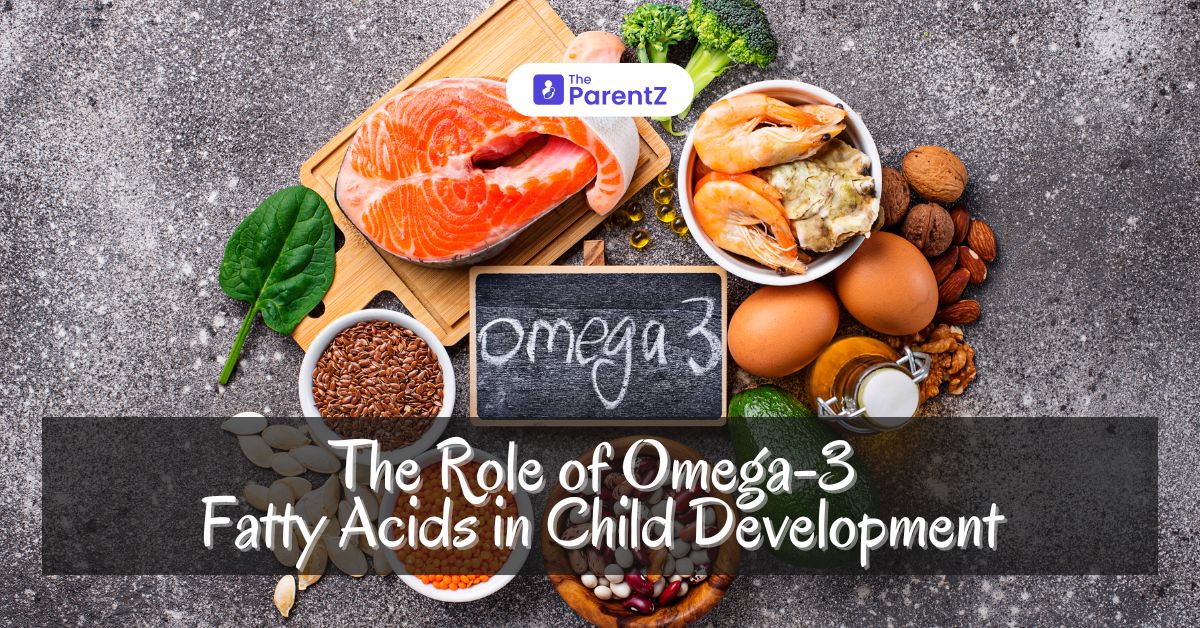Did you know that the human brain is nearly 60% fat? And there are certain fats, particularly omega-3 fatty acids, that are not just important but crucial for your child’s brain development and overall health. Think of these fats as the superheroes of your child’s brain, fighting off villains like poor concentration and memory problems. This knowledge can motivate you to take action for your child’s well-being.
Welcome to the world of omega-3 fatty acids, a group of essential fats that play a vital role in your child’s growth and well-being.
In this article, we will explore how these essential fats contribute to your child’s cognitive development, help fight inflammation, and even improve insulin sensitivity.
What Are Omega-3 Fatty Acids?
Contrary to popular belief, not all fats are bad for you. Omega-3 fatty acids are a type of healthy fat that are essential for your child’s health and development.
Omega-3 fatty acids are polyunsaturated fats vital for many physiological functions. The three most significant types are:
1. Alpha-linolenic acid (ALA): Found in plant oils such as flaxseed, soybean, and chia seeds.
2. Eicosapentaenoic acid (EPA): Primarily found in fatty fish and seafood. A great way to include this in your child’s diet is by serving grilled salmon or tuna sandwiches.
3. Docosahexaenoic acid (DHA): Also found in fatty fish and seafood, DHA is particularly crucial for brain development and function.
Functions of Omega-3 Fatty Acids
Omega-3 fatty acids are integral to numerous bodily functions, including:
1. Brain Development and Cognitive Function:
• DHA is a major structural component of the brain and retina. Adequate levels of DHA during pregnancy and early childhood are associated with improved cognitive development, visual acuity, and overall brain function.
• Existing studies suggest that omega-3 supplementation can enhance attention span, reduce hyperactivity, and improve learning capabilities in children. This means that by incorporating omega-3 fatty acids into your child’s diet, you could be setting them up for a brighter, more successful future.
2. Anti-Inflammatory Properties:
• Omega-3 fatty acids help regulate the body’s inflammatory response. They produce anti-inflammatory eicosanoids, which can mitigate chronic inflammation linked to various diseases. In children, this property may help manage asthma and allergies.
3. Cardiovascular Health:
• By introducing omega-3s into your child’s diet, you are contributing to their cardiovascular health. Omega-3s have been shown to lower blood pressure, reduce triglyceride levels, and prevent arterial plaque formation. This reassurance can give you confidence in your dietary choices for your child.
• Introducing omega-3s early can set the foundation for lifelong heart health.
4. Immune Function:
• Omega-3 fatty acids enhance immune function by modulating immune cell activity. This modulation helps maintain a balanced immune response, reducing the risk of autoimmune diseases.
Omega-3s and Insulin Resistance
Insulin resistance, a precursor to type 2 diabetes, is increasingly prevalent among children due to rising obesity rates.
Omega-3 fatty acids play a role in improving insulin sensitivity. Here’s how:
• Cell Membrane Fluidity: Omega-3s are incorporated into cell membranes, enhancing their fluidity and the function of insulin receptors, which helps improve glucose uptake.
• Anti-inflammatory Effects: Chronic inflammation contributes to insulin resistance. Omega-3s’ anti-inflammatory properties can reduce this risk, promoting better insulin sensitivity and glucose metabolism.
Now that you know the benefits of omega-3 fatty acids, why not start by adding a serving of fatty fish to your child’s diet this week?
The Vital Role of Omega-3 Fatty Acids in Your Child’s Health
Understanding the different types of omega-3 fatty acids is the first step in ensuring your child’s health. These include:
1. Fatty Fish: Salmon, mackerel, sardines, and trout are excellent sources of EPA and DHA.
2. Plant-Based Sources: Flaxseeds, chia seeds, walnuts, and hemp seeds provide ALA, which the body can partially convert to EPA and DHA.
3. Fortified Foods: Some eggs, milk, and yoghurt are fortified with omega-3s.
4. Supplements: Fish oil or algal oil supplements can be helpful, especially for picky eaters or those following a vegetarian or vegan diet.
Recommended Intake
The optimal intake of omega-3s varies by age. The following guidelines can help ensure adequate consumption:
| Age Group | Dosage |
|---|---|
| Infants (0-12 months) | 0.5 grams/day of ALA, emphasizing DHA through breastfeeding or formula |
| Children (1-3 years) | 0.7 grams/day of ALA |
| Children (4-8 years) | 0.9 grams/day of ALA |
| Boys (9-13 years) | 1.2 grams/day of ALA |
| Girls (9-13 years) | 1.0 grams/day of ALA |
These are general guidelines; incorporating DHA and EPA through fish or supplements can offer additional benefits.
Potential Risks and Cautions
While omega-3 fatty acids are undeniably beneficial, it’s important to be aware of potential risks and balance their intake with other nutrients:
1. Mercury in Fish: Some fish, giant predatory species, can contain high levels of mercury, which is harmful, especially to young children. Opt for low-mercury options like salmon, sardines, and trout.
2. Excessive Intake: High doses of omega-3 supplements can lead to adverse effects such as excessive bleeding, gastrointestinal discomfort, and immune suppression. It’s essential to adhere to recommended dosages and consult a healthcare provider before starting supplements.
3. Balance with Omega-6 Fatty Acids: Modern diets often have an imbalance between omega-3 and omega-6 fatty acids, with excess omega-6s leading to inflammation. Strive for a balanced intake by reducing processed foods high in omega-6s and increasing omega-3-rich foods.
Practical Tips for Parents
Don’t worry, incorporating omega-3s into your child’s diet can be both simple and delicious with these strategies:
1. Regular Fish Meals: Aim for two servings of low-mercury fish per week. Incorporate fish into familiar dishes like tacos, pasta, or homemade fish sticks.
2. Snack Smart: Add walnuts, flaxseeds, or chia seeds to snacks like yoghurt, smoothies, or oatmeal.
3. Fortified Foods: Choose omega-3 fortified eggs, milk, and dairy products.
4. Cooking with Oils: Use oils rich in ALA, such as flaxseed or canola, for dressings and low-heat cooking.
5. Supplements: If dietary sources are insufficient, consider omega-3 supplements designed for children, ensuring they meet the daily requirements without exceeding safe limits.
Conclusion
Omega-3 fatty acids are fundamental to a child’s development, impacting brain function, inflammation regulation, insulin sensitivity, and overall health. By incorporating a variety of omega-3-rich foods into your child’s diet and being mindful of potential risks, you can support their growth and development effectively. With informed choices, you can ensure your child reaps the full benefits of these essential nutrients.








Be the first one to comment on this story.